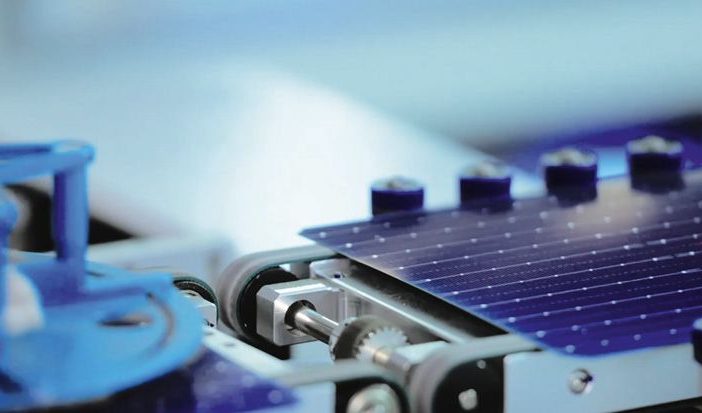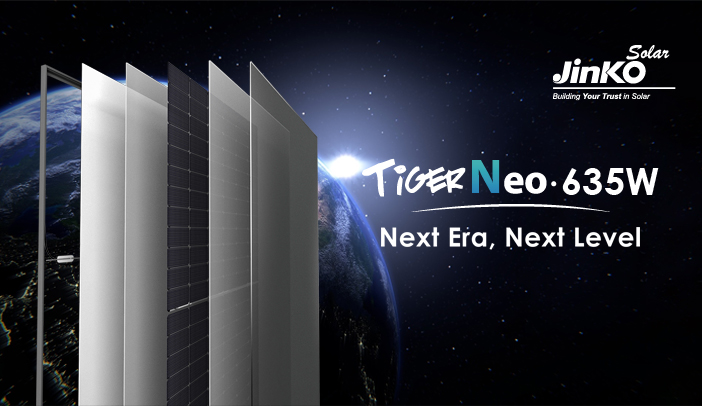- JinkoSolar, the world’s leading solar and storage company, achieved a record-breaking efficiency of 24.76% for its N-type TOPCon large-scale photovoltaic modules, as certified by TÜV Süd, setting a new global record for certified module efficiency by a third-party authority.
In addition, JinkoSolar made a significant breakthrough in the development of perovskite-silicon stacked tandem N-type TOPCon cells, with a conversion efficiency of 32.33%, as tested by the Shanghai Institute of Microsystems and Information Technology, Chinese Academy of Sciences. This achievement substantially enhances the conversion efficiency of similar stacked cells.
Just a short while ago, JinkoSolar announced that its 182mm N-type TOPCon cells achieved a conversion efficiency of 26.89%, as tested by the National Photovoltaic Industry Measurement Testing Center, reclaiming the crown for large-area monocrystalline silicon cells’ efficiency.
Within the span of a week, JinkoSolar’s research and development efforts have continuously achieved significant breakthroughs. These achievements not only represent the innovative results of being a leader in N-type technology but also indicate the future direction for the entire photovoltaic industry’s upgrade in N-type technology.
TOPCon Boosts Sustainability and Implementation
In the current landscape of diverse technological innovations in the photovoltaic industry, N-type TOPCon is undoubtedly one of the most feasible and economical technologies. JinkoSolar’s consistent breakthroughs in both cell and module efficiency further affirm that N-type TOPCon cells are the most promising and competitively sustainable technology for the future.
Dr. Jin Hao, Chief Technology Officer at JinkoSolar, emphasized that improving efficiency while reducing costs is always the main theme of the solar industry. When designing the first generation of N-type TOPCon products, the company had already considered the second and third generations, leaving ample room for new technology integration and efficiency upgrades.
The latest module efficiency record is a result of advanced TOPCon cell metallization enhancement technology, energy particle volume passivation technology, high-efficiency light trapping passivation contact technology, and high-density module packaging technology. These innovations effectively reduce the internal resistance loss of modules, leading to a significant improvement in efficiency, achieving a 24.76% conversion efficiency for large-area photovoltaic modules over 2 sq m. This laboratory record provides a practical foundation for mass production and is expected to accelerate the high-quality implementation of advanced products by the company.
The breakthrough in perovskite-silicon stacked tandem cells utilized JinkoSolar’s independently developed N-type HOT high-efficiency passivated contact cells (TOPCon) as the bottom cell. The development included a new intermediate composite stacked structure and perovskite bulk passivation improvement technology, ensuring high transmission flux and efficient perovskite interface passivation without hysteresis effects. This reaffirms TOPCon as a mainstream technology for the next 3 to 5 years, perfectly integrating with the next generation of stacking technology to break through the efficiency limits of monocrystalline silicon cells.
Dr. Jin Hao explained, “Using TOPCon as the bottom battery and perovskite to achieve high-efficiency stacked batteries has advantages in process implementation. TOPCon, because of its excellent high-temperature stability, can provide a better selection of functional materials for each layer of the top perovskite battery.”
Dr. Jin Hao previously outlined JinkoSolar’s clear path to efficiency improvement for TOPCon cells: achieving an average efficiency of 25.8% in mass production by the end of 2023, reaching an overall module efficiency of 26.5% in 2024 without requiring sophisticated equipment, optimizing production and materials to reach an efficiency level of around 27%, and eventually achieving 27% to 27.5% efficiency over the next 2 to 3 years.
It is evident that JinkoSolar’s innovation is a systematic and strategic approach, rooted in the company’s philosophy of exploring, researching, and producing each generation. The innovation is not speculative but is based on the forefront of technological theory and the current state of the industry market, embedding technological advancements rapidly into all aspects of production and consistently introducing leading products to the market, maximizing the value of innovation.
N-Type Dominance for JinkoSolar’s Sustained Leadership
With continuous accumulation in the field of N-type TOPCon, JinkoSolar has delivered leading performance among first-tier module companies in the first three quarters of this year: shipping 55.2 GW of modules, ranking first in the industry; N-type module shipments accounting for nearly 60%, reaching 29.8 GW; a net profit of CNY 6.35 billion, a nearly threefold year-on-year increase, and the only first-tier module company achieving a profit quarter-on-quarter improvement.
Looking ahead, JinkoSolar anticipates that the proportion of N-type capacity in its overall capacity structure will exceed three-quarters by the end of the year. In the company’s order book, N-type module prices remain stable compared to P-type, and the integrated cost advantages of N-type over P-type modules are gradually becoming apparent. Additionally, the company is investing in the construction of an N-type integrated factory in Shanxi, which is expected to become one of the company’s most important differentiating competitive advantages in the next phase, providing strong support for the sustained growth of the company’s performance.
According to third-party estimates, the global market share of N-type modules is expected to increase from 20-30% in 2023 to 50% or even higher in 2024. Leveraging its technological and scale advantages in the N-type TOPCon field, JinkoSolar is poised to occupy a favorable position in the expanding market share competition for N-type modules.
During the third Belt and Road International Cooperation Summit held in October this year, JinkoSolar signed a 3.8 GW N-type module agreement with ACWA Power, a Saudi international power and water company. Coincidentally, in September 2023, JinkoSolar won bids for approximately 3.2 GW of projects using N-type modules from the CHN ENERGY Investment Group Co., Ltd. The signing of these long-term contracts signifies global recognition for JinkoSolar’s efficient N-type modules.
Currently, the production progress of some companies in the industry for N-type cells is slower than expected, leading to insufficient supply of high-efficiency N-type products. Due to the complexity and continuous iteration of N-type technology, the gap between technology leaders and followers may gradually widen in the future.
Thanks to the advantages of integrated production and innovation, as well as its leadership position in the N-type field, JinkoSolar has distinct advantages in equipment and raw material supply throughout the entire N-type industry chain, ensuring reliability and high coordination between each link and the module. JinkoSolar has already applied laser SE technology and new metallization technology, with the industry following suit. Dr. Jin Hao stated that, with the future planning and implementation of the company’s double-sided technology and other follow-up technological routes, JinkoSolar is confident in maintaining a technological lead of more than half a year over following enterprises.
Author: Bryan Groenendaal
















